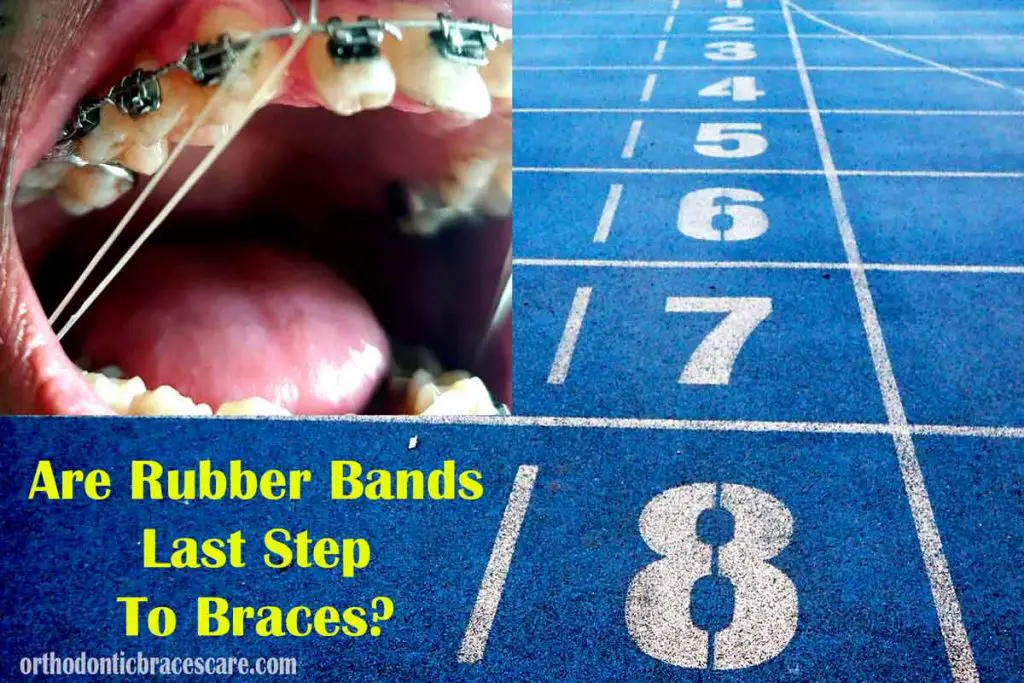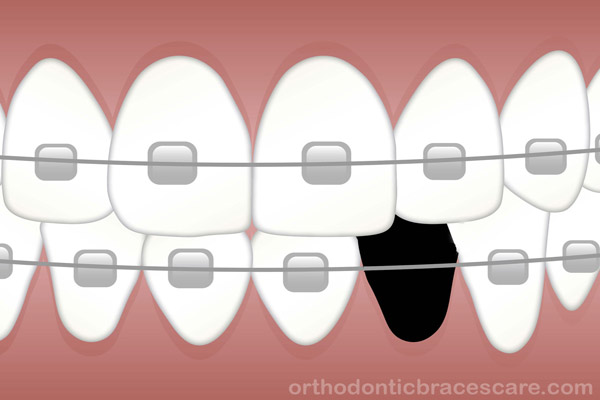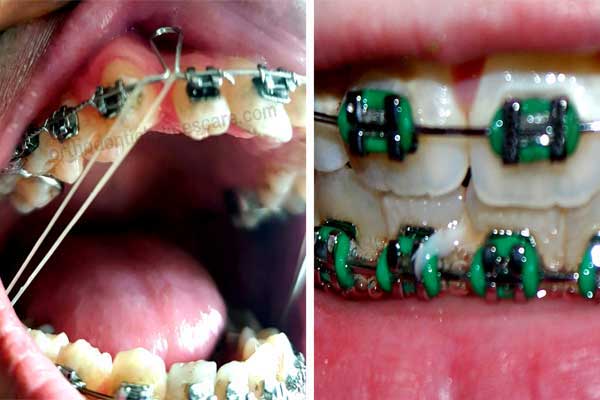Last updated on July 27th, 2022 at 02:00 pm
When the orthodontist suggests you wear rubber bands for braces, you may be curious to know, “Are Rubber Bands the Last Step To Braces?”
In short, if tooth alignment is completed and you need bite correction, the rubber bands can be the last step to braces. But, sometimes, you may also need the elastics in the early or mid-stage of treatment to help teeth movement. Since no two cases are the same, they may differ amongst individuals.
The complexity of the case, the type of bites, and treatment planning all affect when it should be used.
But, how can you find out on your own when your orthodontist can use these in the last stage of braces treatment?
To do so, you have to know a few more important things. That is why we’ll look at the variations in time to get rubber bands on braces so you can compare them to your situation.
In this article, we’ll answer your questions-
- How long after rubber bands’ braces come off?
- After getting a rubber band, How can I get my braces off sooner?
Before we begin, one point should be made clear. There are various kinds of elastic bands. Power chains, which are also formed of elastics, should not be mistaken. Power chains can also be the last step to braces.
When do you start wearing rubber bands for braces?

Rubber bands on braces are used to fix an overbite, underbite, and open bites to help straighten teeth and give you beautiful smile. Usually, you may have them on either side of the jaw. But, sometimes, you may have them on one side.
Not everyone gets the rubber bands or inter-arch elastic bands. Sometimes, you may get springs and other types of equipment with braces to move teeth. But, overall, the rubber band is commonly used in orthodontic treatment.
There are various types of rubber bands such as – class 2, class 3, box, triangle, and more.
In orthodontics, we call them class 2 and class 3 elastic for a reason.
In class 2 case you have an increased overbite and in class 3 you have an underbite.
According to this, the rubber band is named class 2 and class 3 elastic.
Other types are box and triangle elastics. If you have an open bite, you may need them.
Your orthodontist will decide which types of braces you need. You can only choose the color of the rubber band.
In class 2 case, he or she will put one end of the rubber band on the bracket of the upper canine tooth and another end on the bracket of lower molars. In class 3, it’s the opposite.
So, how do these elastics work? Do rubber bands move your jaw or teeth?
Yes, just like the archwire rubber band puts a force on the tooth and bone through brackets and helps move the tooth or jaw in the desired position.
For example, class 2 elastics bring the lower jaw forward whereas class 3 elastics bring it backward.
Now, you know, how important they are for your treatment. But, are these elastic last stages of braces?
Stages of Braces and Using Rubber Bands
If you know how many stages of braces there are, you can probably anticipate whether the rubber band will be the final step in your braces treatment.
We need to complete orthodontic treatment in two phases. Those are – the active and retention phases.
The active phase is the time when you visit your orthodontist frequently and various procedures are done. You have to wear braces in this phase.
And, after the braces come off, the retention phase begins. During this stage, you must wear a retainer to hold the teeth in their new position.
The rubber band is part of the active treatment phase. Now, let’s look at the stages of braces treatment and try to figure out when you start wearing rubber bands for braces.
1. Planing and extraction or arch expansion
Your orthodontist do all measurements and plan the treatment. The type of case determines the planning. Which equipment or appliances you require also depends on the case.
Tooth extraction may be necessary if you have crowding or a lack of space in your jaw for your teeth.
Check out when you need tooth removal for braces from my other article.
Sometimes to gain space, your orthodontist may suggest an arch expansion procedure. If you have a lot of space between teeth, it may need to fix early.
The rubber band has no use at this stage, because it works only with braces.
2. Getting braces
At this stage, you get braces. Your orthodontist places brackets on your teeth using braces glue or adhesive. This process is called bonding.
3. Teeth labeling and alignment
The orthodontist uses various types of equipment according to the need in this stage. The goal of this stage is to align your teeth properly in their respective jaw/arch and label them.
The orthodontist uses archwires to apply a force on the tooth through brackets to move your teeth. He/she may also use an elastic chain or power chain and springs.
In this stage, the misalignment of the individual arch is corrected. It’s unlikely that you get a rubber band at this point.
4. Bite correction
After the teeth in each arch have been properly aligned, your orthodontist must establish a proper relationship between both arches so that you may bite correctly and comfortably. To fix it, he/she must first determine whether you have an overbite, underbite, or open bite.
As we discussed rubber band is used to correct the open bite, overbite, or underbite, this is the stage when you can get rubber bands (inter-arch elastic bands).
But, sometimes, the orthodontist may decide to use springs for bite correction instead of those elastic bands.
Now, the question is, are rubber bands the last stage of braces?
If you notice that all of your teeth are almost properly aligned and that any overbite or underbite will just be corrected, you can rejoice since you are closing to finish your braces treatment.
So, in this situation, rubber bands are the last step to braces.
After the rubber band completes its work, your orthodontist may remove braces and give you a retainer.
But, in some cases, elastic bands may not be the last step. If your orthodontist feels there is more work needed to be done, he/she may place other types of equipment for that.
So, honestly speaking, only your orthodontist can tell you when your braces will be removed.
Before the removal of braces, you may have to wear other types of elastic, called power chains to close the residual gaps between teeth.
5. Removal of braces and Getting retainers
Finally, there’s the long-awaited time. This is the braces finishing stage. So, your orthodontist will take off your braces and you’ll have a beautiful smile.
However, you’ll get a retainer to hold your teeth in their current position and prevent their movement to the original position.
How long after rubber bands do braces come off?
Your orthodontist may take off braces after 6 to 8 months of getting rubber bands. However, it varies from person to person and depends on the type and severity of the case.
Moreover, there are some important factors that determine how long you have to wear rubber bands for braces.
Now, as you know, the rubber band can be the final step before braces come off, you may have a few more questions to ask.
How can I get my braces off sooner, after getting a rubber band?
Here are some tips to get rubber band and braces off sooner.
- Wear rubber bands all the time except for brushing and sometimes during eating.
- Never double up your rubber band. Otherwise, it may damage your teeth and you’ll lose progress.
- Replace the elastic band regularly.
- Don’t take a break from rubber bands. Know what happens if you don’t wear rubber bands with braces.
- You should eat with a rubber band and then replace it with the new one after that.
- Follow all instructions given by your orthodontist.
- Eat easy to chew and braces friendly food. Avoid hard and sticky foods.
- Don’t buy rubber band on your own. Use the bands provided by your orthodonist.
- Clean your braces and teeth thoroughly at regular basic.
But, how often do you have to change rubber bands for braces?
You can change the rubber band 3 to 4 times a day. Change it after waking up in the morning and after meals.
To get maximum benefit, you may need to wear the elastic for 22 to 24 hours, if it’s possible. But, always consult with your orthodontist and follow his or her advice.
Another question is, what happens if you don’t wear your rubber bands?
The answer is simple, it won’t work properly and you won’t get the best outcome. Treatment time will be prolonged and you have to keep wearing braces for a longer duration.
I think you have got the answer to the question, “Can I just wear my rubber bands at night, Should I wear elastics while sleeping?”
Of course, you have to wear a rubber band while sleeping. If you don’t, treatment progress will be slow.
Are elastics the last stage of braces?
Elastic can be the last stage of braces, but it depends on the complexity of your case and the types of elastic you get. If you get inter-arch rubber bands, they can be used to correct bites at the final stage of braces. Sometimes, power chains can also be used at the last step to close teeth gaps. On the other hand, elastic ties are worn during all stages of braces treatment.
However, you can also get inter-arch elastic bands and power chains during the early stage of treatment.
Finally, you can also check our recommended braces care kit.
Takeaways
Although braces can be removed a few weeks after the rubber bands are removed, they can be used sooner in many circumstances. Whether rubber bands are the last step to braces depends on the treatment plan designed by the orthodontist and the types of cases.

Dr. Pallab Kishore, MS in Orthodontics and owner of Orthodontic Braces Care, shares expert tips on braces, aligners, and oral health from 10+ years of experience.


